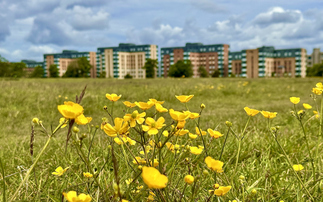How will the global pledge to 'protect, restore and promote sustainable use of terrestrial ecosystems' shape the global economy?
Targets
15.1 By 2020, ensure the conservation, restoration and sustainable use of terrestrial and inland freshwater ecosystems and their services, in particular forests, wetlands, mountains and drylands, in line with obligations under international agreements.
15.2 By 2020, promote the implementation of sustainable management of all types of forests, halt deforestation, restore degraded forests and substantially increase afforestation and reforestation globally.
15.3 By 2030, combat desertification, restore degraded land and soil, including land affected by desertification, drought and floods, and strive to achieve a land degradation-neutral world.
15.4 By 2030, ensure the conservation of mountain ecosystems, including their biodiversity, in order to enhance their capacity to provide benefits that are essential for sustainable development.
15.5 Take urgent and significant action to reduce the degradation of natural habitats, halt the loss of biodiversity and, by 2020, protect and prevent the extinction of threatened species.
15.6 Promote fair and equitable sharing of the benefits arising from the utilization of genetic resources and promote appropriate access to such resources, as internationally agreed.
15.7 Take urgent action to end poaching and trafficking of protected species of flora and fauna and address both demand and supply of illegal wildlife products.
15.8 By 2020, introduce measures to prevent the introduction and significantly reduce the impact of invasive alien species on land and water ecosystems and control or eradicate the priority species.
15.9 By 2020, integrate ecosystem and biodiversity values into national and local planning, development processes, poverty reduction strategies and accounts.
15.A Mobilize and significantly increase financial resources from all sources to conserve and sustainably use biodiversity and ecosystems.
15.B Mobilize significant resources from all sources and at all levels to finance sustainable forest management and provide adequate incentives to developing countries to advance such management, including for conservation and reforestation.
15.C Enhance global support for efforts to combat poaching and trafficking of protected species, including by increasing the capacity of local communities to pursue sustainable livelihood opportunities.
Progress to date
SDG15 is one of the big ones, encompassing all life on land and as such informing all the other SDGs.
"Uneven" is the word the UN uses to describe progress to date against SDG15, and if anything that is an understatement. There has been considerable progress slowing rates of deforestation, while funding and new legislative protections for land-based ecosystems have increased at an unprecedented rate. Yet at the same time rates of biodiversity loss that have prompted some scientists to refer to a "great extinction" continue to accelerate and worsening desertification is said to threaten the livelihoods of one billion people.
However, even where progress is being made it is questionable whether the world is on track to meet SDG15. For example, target 15.2 promises to halt deforestation and substantially increase reforestation globally by 2020. The UN's latest progress report confirms there has been an underreported revolution in forest protection. From 2010 to 2015, the annual net loss of forest area globally was less than half that of the 1990s. As such, the proportion of land area covered by forest fell from 31.6 per cent in 1990 to 30.8 per cent in 2010 but then dropped only slightly to 30.6 per cent in 2015.
But at the same time forest loss is continuing and many countries in South America, Africa, and South East Asia are struggling to enact effective forest management policies in the face of expanding agricultural industries. Meanwhile, as the high stakes election in Brazil proves, recent progress in tackling deforestation in many of the world's most forested nations is always one populist government away from being reversed.
Fears also remain that escalating climate impacts could see progress on forest protection halted. And at the same time climate change and unsustainable land management practices are fuelling worrying desertification trends globally. "About one fifth of the Earth's land surface covered by vegetation showed persistent and declining trends in productivity from 1998 to 2013," the UN progress report states. "Up to 24 million square kilometres of land was affected, including 19 per cent of cropland, 16 per cent of forest land, 19 per cent of grassland and 28 per cent of rangeland. In some cases, advanced stages of land degradation are leading to desertification in dryland areas, particularly in the grasslands and rangelands."
Forest loss, desertification, invasive species, and damage to marine habitats are all contributing to biodiversity loss that is continuing at "an alarming rate", according to the UN. The Red List Index, which measures species extinction risk has fallen from 0.82 in 1993 to 0.74 globally. Meanwhile, illicit poaching and trafficking of wildlife "continues to thwart conservation efforts", according to the UN, with nearly 7,000 species of animals and plants reported in illegal trade involving 120 countries.
However, some encouragement is to be found in the global response to the crisis in biodiversity. From 2000 to 2017, average worldwide coverage of terrestrial, freshwater, and mountain key biodiversity areas by protected areas increased from 35 per cent to 47 per cent, 32 per cent to 43 per cent, and 39 per cent to 49 per cent, respectively.
Since 2010, the percentage of countries that have enacted national legislation relevant to tackle invasive alien species has increased by 19 per cent. As of February 2018 105 countries have ratified the Nagoya Protocol on biological diversity - up from 96 countries in 2017 - and 144 contracting parties have backed the International Treaty on Plant Genetic Resources for Food and Agriculture.
However, Overseas Development Aid earmarked for biodiversity continues to fluctuate having risen 39 per cent in 2015 to $8.8bn before falling 21 per cent to $17bn in 2016.
Business implications
As any business that has found itself under fire over the way its supply chain contributes to deforestation will know, land use has huge implications for businesses, even if the land use in question is thousands of miles away.
A failure to deliver on SDG15 would have grave consequences for food security, water security, climate change, ecosystem services, and economic development, especially in poorer nations. Consumer facing brands and agri-businesses face the biggest risks from an erosion of land-based habitats and the loss of iconic species, but ultimately the economy as a whole benefits from sustainable land management. As such, all businesses stand to benefit from SDG15 targets being met, especially when any costs are offset by the properly accounted for benefits that result from cleaner air, soils, and water, not to mention a stable climate.
Action to deliver on SDG15 targets will also have a raft of specific implications for businesses, ranging from changes to agricultural and planning policy to increased funding for biodiversity protection and 'green' infrastructure measures.
Done well changes to agricultural subsidies and land management policies could incentivise sustainable practices that open up new revenue streams, minimise environmental impacts, and unlock a raft of economic co-benefits. However, such reforms can quickly become overly bureaucratic and have a tendency to unleash unintended consequences. Some businesses and economies will also remain fearful that an expansion of protected areas and more demanding environmental standards will push up costs for businesses and slow development in some countries, despite mounting evidence that current trends are unsustainable.
Business risks
The inter-related nature of life on land means there are considerable and varied business risks associated with SDG15. For example, deforestation can lead to desertification and disruption to the water cycle, which will be further exacerbated by climate change. That in turn leads to reductions in agricultural productivity and water stress, meaning that businesses around the world can suddenly face a complex web of cost risks, operational risks, stranded asset risks, and reputational risks.
The fact a fifth of the world's land surface covered by vegetation is showing signs of falling productivity serves to highlight the scale of the risk, especially when rising demand for food and climate change could serve to accelerate desertification trends.
As such, businesses with any engagement with land use, either directly or through their supply chains, can expect to face increasing pressure from consumers, investors, and regulators for them to adopt more sustainable practices. Those still engaged in unsustainable practices - for example, still relying on deforestation - need to be aware they are working in contradiction of the globally stated goals of the world's governments.
For those keen to support the targets set out under SDG15 there are still risks to consider, as the likely introduction of larger protected areas, more robust planning rules, agricultural subsidy reforms, and efforts to tackle invasive species could lead to an increased administrative burden and related costs.
Business opportunities
The field of ecosystem services is not always well understood, but SDG15 has the potential to unlock a raft of new nature-reliant services that will serve to bolster climate resilience, drive economic growth, and create new business opportunities.
For example, improved forest management in upland areas has been shown to reduce soil erosion, drastically cut downstream flood risks, enhance water security, and generate tourism for a region, benefitting businesses of all types as a result. The insurance industry and food and drink giants increasingly understand this reality with some seizing the opportunity to actively invest in forest protection and improved land management in order to realise the risk reduction and reputational benefits.
Further downstream more sustainable agricultural practices serve to boost long term yields, while numerous studies have shown access to nature aids mental health and employee productivity.
Changes to planning systems to protect biodiversity can seem like red tape, but done properly reforms result in more sustainable developments that enjoy lower risk profiles and higher long term returns for businesses and investors. Similarly, reforming agricultural subsidies, as is currently proposed in the UK, promises to open up new revenue streams for farmers and land owners who actively manage their land to deliver environmental services that provide public goods.
For the extractive industries specifically, more robust sustainability strategies may add costs but they are also a mechanism of responding to public demands and securing the long term future of sectors such as mining and forestry.
Finally, the pledge to integrate ecosystem and biodiversity values into national policies hints at an expansion for the controversial biodiversity offset and natural capital accounting sectors. The idea of paying to offset damage done to habitats remains highly contentious in environmental circles, but advocates insist it could open up an important new market for businesses that would result in significant net benefits for the natural world.









